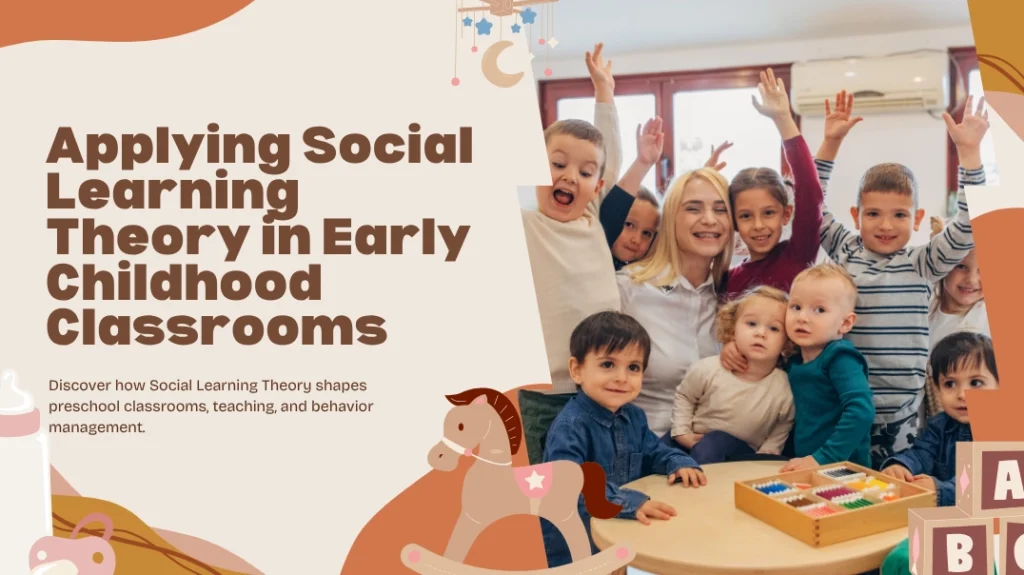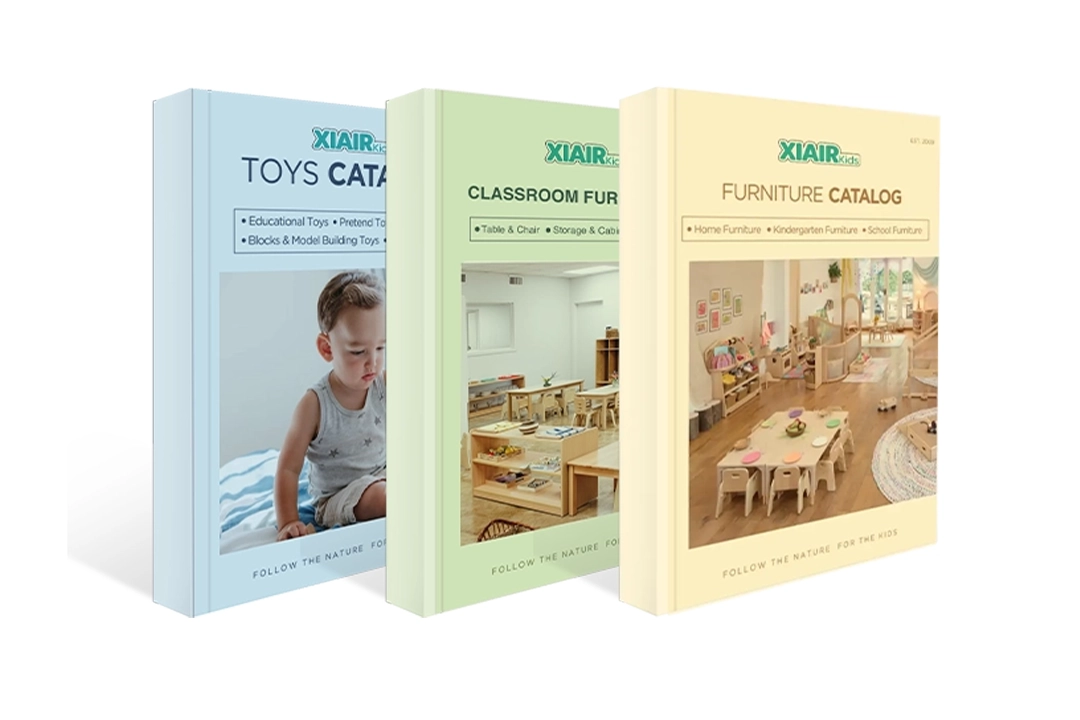Many teachers and parents struggle to help young children learn the right behaviors and social skills. Children often pick up habits that are hard to change, and straightforward advice or strict rules don’t always work. This can leave adults feeling frustrated and unsure of how to guide children in the classroom or at home.
Have you ever watched a child ignore your instructions but copy something a friend or adult did, good or bad? Have you wondered why some children quickly learn to share and cooperate, while others struggle? The truth is, kids are always watching, learning, and copying, even when we’re not trying to teach them. If we don’t understand how children learn from others, we miss the chance to help them build strong, positive habits early in life.
That’s where Social Learning Theory comes in. Social Learning Theory explains how children learn by observing others, modeling behavior, and practicing what they see in real life. When we use Social Learning Theory in early childhood education, we can make learning social, natural, and much more effective. With the right approach, teachers and parents can shape young children’s social skills, confidence, and behavior in simple, powerful ways—turning every moment into a learning opportunity.
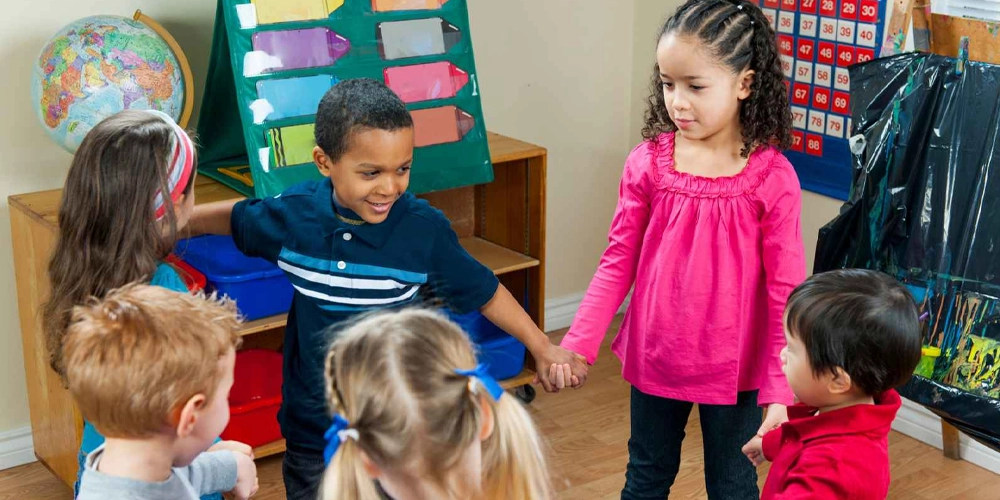
Introduction
Social Learning Theory is one of the most practical and easy-to-understand ways to help young children grow, both at school and at home. Developed by psychologist Albert Bandura, Social Learning Theory shows that children learn best by watching and copying others, whether it’s their teacher, classmates, parents, or siblings. This simple but powerful idea shapes everything from classroom routines and playground games to how children build friendships and solve problems.
In early childhood education, Social Learning Theory is more than just a teaching tool. It’s a foundation for building positive classroom cultures, guiding child development, and supporting children as they learn new behaviors. From lesson planning and classroom management to family life and daily routines, the theory helps adults model good habits, encourage social skills, and reinforce the right choices with gentle, real-life examples.
This article explores how Social Learning Theory transforms early childhood education. We’ll look at the theory’s history, main ideas, and the ways it’s used every day in preschools and homes around the world. You’ll discover how to use Social Learning Theory in the classroom, create activities that work, manage behavior, and even involve parents and families in the process. Whether you’re a teacher, parent, or early childhood professional, these practical insights will help you make every day a new chance to help children learn and grow through the power of social learning.
What is Social Learning Theory in Early Childhood?
Social Learning Theory is at the heart of how young children develop social skills, habits, and attitudes in their earliest years. In early childhood education, this theory explains why simply telling children what to do is less effective than showing them positive behaviors in action. By watching adults and peers, children pick up ways of speaking, behaving, and solving problems that they will use for the rest of their lives.
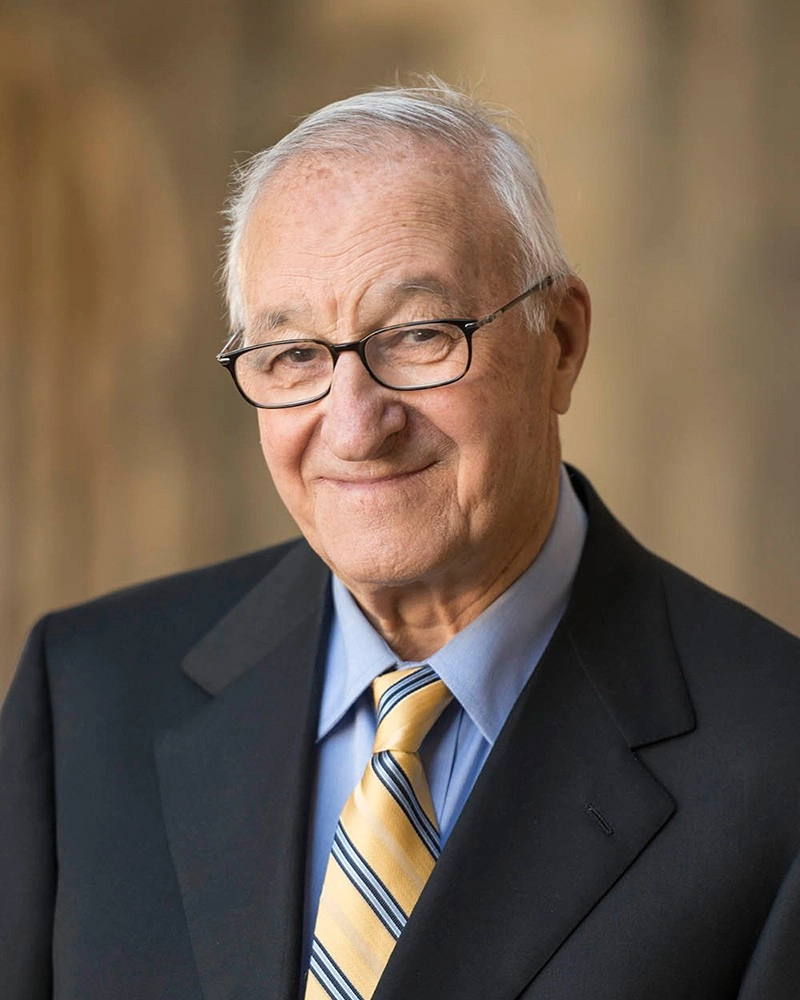
Who is Albert Bandura?
Albert Bandura was one of the most influential psychologists of the twentieth century. Born in Canada, he became world-famous for introducing Social Learning Theory, which changed how experts think about child development. In the 1960s, Bandura conducted the well-known Bobo Doll experiment. In this study, young children watched adults act either kindly or aggressively toward a toy doll. The children who observed aggressive behavior were much more likely to act out those same behaviors themselves. This experiment proved that children not only learn from what happens to them directly, but they also learn by watching and imitating others. Thanks to Bandura, Social Learning Theory is now a foundation for early childhood education all over the world.
Bandura’s work also introduced other key ideas like modeling, observational learning, and self-efficacy—concepts that help teachers and parents understand why children copy both good and bad behaviors they see.
Social Learning Theory Explained Simply
Social Learning Theory, at its core, says that children are like “little scientists”—always observing, experimenting, and learning from the world around them. They pay close attention to how adults and peers behave, speak, and react in different situations. In preschool and at home, this means that children are constantly watching how teachers and parents interact, how classmates share toys, or how older siblings solve arguments.
Unlike theories that focus only on direct teaching or punishment, Social Learning Theory recognizes that much of what children learn happens “in the background”—through everyday observation and natural imitation. For example, a child who sees classmates washing their hands after painting is likely to follow along, even if the teacher never says a word. This is why Social Learning Theory in preschool settings is so influential: children are always learning, even when it seems like they’re just watching.
Why Social Learning Theory Matters for Teachers and Parents
Understanding Social Learning Theory helps teachers and parents take a more thoughtful approach to guiding children’s growth. In early childhood classrooms, teachers are not just instructors—they are also constant role models. Every action a teacher takes, from speaking kindly to managing conflicts, sets an example for the children to follow. This is why Social Learning Theory for preschool teachers is so critical: children are learning “how to be” by watching what adults do, not just what they say.
At home, parents play the same critical role. Children copy how parents solve problems, express feelings, handle mistakes, and interact with others. When adults show patience, honesty, or teamwork, children are much more likely to develop these traits themselves. Social Learning Theory in parenting means that a parent’s daily choices—even small ones—can shape a child’s habits for years to come.
Social Learning Theory also helps teachers and parents understand why certain behaviors spread quickly in a classroom or family. If a child sees a peer being praised for sharing, they are more likely to share as well. This is called “vicarious reinforcement,” and it’s one of the main reasons Social Learning Theory in early childhood education is so practical.
The Power of Role Models in Preschool
In every early childhood setting, role models are everywhere. Teachers are often the first and most important role models outside the family, but children also look up to older kids, classmates, and even storybook characters. Social Learning Theory classroom examples show that children are more likely to imitate someone they admire or someone who is rewarded for good behavior.
Role models can be positive or negative. A teacher who patiently solves problems without shouting is modeling emotional control. A classmate who always helps others is modeling kindness. On the other hand, if children see a peer being mean without consequence, they might copy that as well. Social Learning Theory classroom management focuses on making sure positive models are always visible.
In practice, teachers and parents can use Social Learning Theory by talking out loud about their choices (“I’m going to use my words, not my hands, when I’m upset”) and by making sure good behaviors are recognized. Social Learning Theory in the classroom works best when adults and children work together as a team, learning from each other every day.
Everyday Examples in the Classroom
Social Learning Theory in preschool is not just an abstract idea; it’s alive in every part of classroom life. Here are some clear, real-world examples:
- When a teacher greets each child with a smile and a “good morning,” children learn to greet each other politely.
- During cleanup time, children who see their friends quickly putting away toys are more likely to help out, too.
- A teacher uses a reward chart to praise children who share. Soon, even quiet children start sharing more, hoping to be noticed and praised.
- When a child struggles with frustration, a teacher might say, “I see you’re upset. Watch how I take a deep breath to calm down.” Other children watching learn this strategy, too.
- In group activities, one child helps a peer tie their shoes. The next day, more children start offering to help classmates.
These everyday classroom situations show how Social Learning Theory in early childhood education turns ordinary moments into powerful lessons for social and emotional growth.
The Development and History of Social Learning Theory
Before Social Learning Theory became popular, most experts believed that children learned only through direct experience, either being rewarded for good behavior or punished for mistakes. But over time, psychologists began to notice that children could learn new behaviors simply by watching what happened to others. This insight changed the way we think about teaching, parenting, and even everyday interactions between children.
The Roots of Social Learning Theory
Social Learning Theory was first developed in the mid-20th century, a time when ideas about human behavior were changing fast. Earlier theories, like behaviorism, focused mainly on what could be seen and measured: actions, rewards, and punishments. But some psychologists, including Albert Bandura, saw that this approach missed a big part of the picture—how children learn by observing and imitating.
Bandura’s research showed that children don’t always need to experience everything for themselves to learn. Instead, by simply watching adults and other children, they can pick up new skills, language, social habits, and even emotional responses. Social Learning Theory introduced a new focus on observation, role models, and group influence in early childhood education.
The Bobo Doll Experiment: A Turning Point
One of the most famous experiments in psychology, the Bobo Doll study, helped prove Social Learning Theory. In this experiment, Bandura and his team had children watch adults interacting with a large inflatable doll. Some adults were gentle and kind; others were aggressive. When the children were later given the chance to play with the doll, those who had seen aggressive behavior often copied it, even using the exact words or movements. Those who saw kindness or cooperation were more likely to act that way themselves.
This study showed that kids in preschool and early childhood settings absorb more than we realize, simply by watching the people around them. This insight led educators to rethink how to structure classrooms and plan activities, and helped create new approaches to teaching and discipline.
How Social Learning Theory Grew in Early Childhood Education
After Bandura’s work became well known, teachers and researchers began using Social Learning Theory in real classrooms and childcare centers. Early childhood educators saw that positive role models—teachers, older children, and even parents—were the best way to teach social skills and build good habits. The theory was soon woven into preschool curriculum, behavior management, and lesson planning.
Today, Social Learning Theory in preschool and primary education shapes everything from classroom routines to conflict resolution. Teachers use it when they plan group activities, set up reward systems, or encourage children to solve problems together. Parents also use Social Learning Theory at home, often without even knowing it, by modeling politeness, sharing, and emotional control.
Social Learning Theory in the Modern Classroom
Over the years, Social Learning Theory has been combined with other ideas, such as social cognitive theory and developmental psychology. Modern classrooms use a mix of strategies, but the basic concept remains the same: children learn best by watching, practicing, and getting feedback from people they trust.
In today’s early childhood environments, Social Learning Theory is visible in peer learning, group projects, classroom jobs, and even the way teachers talk about feelings and behavior. By understanding the history and growth of Social Learning Theory, teachers and parents can use it more effectively to help every child succeed.
The Development and History of Social Learning Theory
Before Social Learning Theory became popular, most experts believed that children learned only through direct experience, either being rewarded for good behavior or punished for mistakes. But over time, psychologists began to notice that children could learn new behaviors simply by watching what happened to others. This insight changed the way we think about teaching, parenting, and even everyday interactions between children.
The Roots of Social Learning Theory
Social Learning Theory was first developed in the mid-20th century, a time when ideas about human behavior were changing fast. Earlier theories, like behaviorism, focused mainly on what could be seen and measured: actions, rewards, and punishments. But some psychologists, including Albert Bandura, saw that this approach missed a big part of the picture—how children learn by observing and imitating.
Bandura’s research showed that children don’t always need to experience everything for themselves to learn. Instead, by simply watching adults and other children, they can pick up new skills, language, social habits, and even emotional responses. Social Learning Theory introduced a new focus on observation, role models, and group influence in early childhood education.
The Bobo Doll Experiment: A Turning Point
One of the most famous experiments in psychology, the Bobo Doll study, helped prove Social Learning Theory. In this experiment, Bandura and his team had children watch adults interacting with a large inflatable doll. Some adults were gentle and kind; others were aggressive. When the children were later given the chance to play with the doll, those who had seen aggressive behavior often copied it, even using the exact words or movements. Those who saw kindness or cooperation were more likely to act that way themselves.
This study showed that kids in preschool and early childhood settings absorb more than we realize, simply by watching the people around them. This insight led educators to rethink how to structure classrooms and plan activities, and helped create new approaches to teaching and discipline.
How Social Learning Theory Grew in Early Childhood Education
After Bandura’s work became well known, teachers and researchers began using Social Learning Theory in real classrooms and childcare centers. Early childhood educators saw that positive role models—teachers, older children, and even parents—were the best way to teach social skills and build good habits. The theory was soon woven into preschool curriculum, behavior management, and lesson planning.
Today, Social Learning Theory in preschool and primary education shapes everything from classroom routines to conflict resolution. Teachers use it when they plan group activities, set up reward systems, or encourage children to solve problems together. Parents also use Social Learning Theory at home, often without even knowing it, by modeling politeness, sharing, and emotional control.
Social Learning Theory in the Modern Classroom
Over the years, Social Learning Theory has been combined with other ideas, such as social cognitive theory and developmental psychology. Modern classrooms use a mix of strategies, but the basic concept remains the same: children learn best by watching, practicing, and getting feedback from people they trust.
In today’s early childhood environments, Social Learning Theory is visible in peer learning, group projects, classroom jobs, and even the way teachers talk about feelings and behavior. By understanding the history and growth of Social Learning Theory, teachers and parents can use it more effectively to help every child succeed.
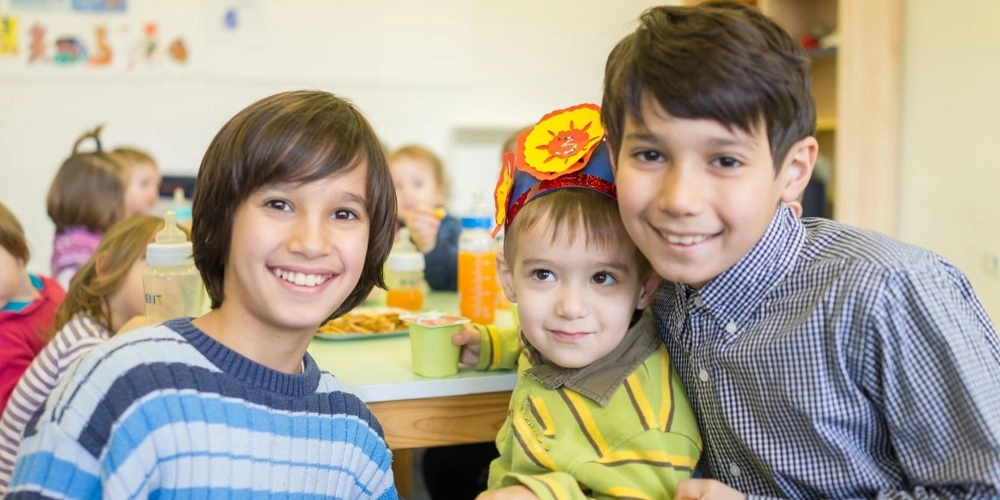
Core Concepts and Mechanisms of Social Learning Theory
Social Learning Theory in early childhood education is more than just a single idea—it’s a collection of connected concepts that help explain exactly how children learn from the people around them. By understanding these key mechanisms, teachers, preschool staff, and parents can guide children’s growth with confidence and intention.
Observational Learning in Action
Observational learning is the heart of Social Learning Theory. Children, especially in preschool and early childhood settings, are constantly watching the world around them. They notice how adults greet one another, how classmates share toys, and how siblings solve disagreements. These daily observations are not just background noise—kids are soaking up everything, even if they don’t seem to be paying close attention.
For example, a child in a preschool classroom might watch as their teacher helps a friend tie their shoes with patience and encouragement. The next day, the same child may try to help a peer or ask for help using similar words. At home, children observe parents apologizing after a mistake or celebrating a small victory. Social Learning Theory shows that what children see every day quickly becomes what they believe is “normal” and “right.”
This kind of learning is powerful because it doesn’t require formal teaching or step-by-step instructions. Just by being part of a group, children learn the social skills, routines, and behaviors that help them succeed in both school and life.
Imitation and Practice
Imitation is what happens after children observe a behavior. They don’t just watch—they try to copy. Social Learning Theory in early childhood is all about this leap from seeing to doing. Sometimes, the first attempt at imitation is clumsy or incomplete. A child may say “please” but in a whisper, or try to stack blocks the way a friend does, but knock them over. Practice is a key part of this process.
Teachers and parents play a huge role in making imitation successful. When adults break down skills into simple steps, give children time to practice, and offer gentle encouragement, kids are more likely to succeed. Social Learning Theory classroom activities—like singing songs together, practicing handwashing, or taking turns in a group game—give children many chances to imitate and improve.
It’s also important to remember that children sometimes imitate things we wish they wouldn’t. Social Learning Theory for classroom management means watching out for negative behaviors that can spread if not addressed quickly.
Modeling: Role Models and Peer Influence
Modeling is about more than just being watched; it’s about who children choose to watch and copy. Social Learning Theory in the classroom and at home shows that not all models are equal. Children are more likely to imitate people they admire, trust, or want to be like.
Teachers are powerful role models in early childhood settings. When a teacher speaks with kindness, shows patience during a tough moment, or admits a mistake and tries again, children learn from every action. But peer modeling is just as strong. If a child sees a classmate being included for helping, they are more likely to want to help too.
Parents and caregivers are the original role models. Social Learning Theory for parenting means knowing that everyday actions—like sharing, being polite, or handling stress—are teaching tools for children.
Peer influence can be both positive and negative. Social Learning Theory classroom examples include “buddy systems,” where older or more experienced children model skills for younger ones. At the same time, if negative behaviors like teasing or grabbing toys are rewarded with attention, those behaviors can quickly spread.
Reinforcement and Vicarious Reinforcement
Reinforcement is what makes a behavior stick. Social Learning Theory in preschool classrooms is full of examples: a teacher smiles and gives a sticker for sharing, a group claps for a classmate who cleans up, or a parent gives extra story time for following directions.
Positive reinforcement is about rewarding behaviors we want to see more of—like cooperation, listening, or helping. This can be praise, a high-five, a favorite activity, or an exceptional job in class. Negative reinforcement or gentle consequences can help guide children away from unwanted behaviors, but Social Learning Theory stresses the power of positive feedback.
Vicarious reinforcement is when a child sees someone else being rewarded (or facing a consequence) and changes their behavior because of it. For instance, if one child receives praise for raising a hand, other children may try raising their hands next time. Social Learning Theory classroom activities, such as public praise or visible reward charts, take advantage of this effect to build positive habits across the whole group.
The Four Steps of Observational Learning
Bandura’s Social Learning Theory is built around four key steps that must happen for a behavior to be learned through observation:
- Attention: The child must notice the behavior. In a busy classroom, teachers use engaging actions, clear words, and visual cues to draw attention. Children are more likely to watch adults or peers who are respected, enthusiastic, or get positive attention from others.
- Retention: The child must remember what was observed. Repeating behaviors, using visual aids, or connecting new skills to familiar routines helps children remember what they see. Teachers might use songs, stories, or classroom displays to boost retention.
- Reproduction: The child needs the ability to copy the behavior. This means both physical ability (like zipping a coat) and mental readiness. Teachers and parents support reproduction by providing practice, patience, and feedback.
- Motivation: The child needs a reason to want to imitate the behavior. Motivation can come from internal pride, desire for praise, or seeing others rewarded. Social Learning Theory classroom strategies often build motivation through group celebrations, visible progress, and meaningful rewards.
If any of these steps are missing, the behavior may not be learned or repeated. This model helps teachers and parents identify where a child might be struggling and how to help.
Self-Efficacy in Social Learning Theory
Self-efficacy is a child’s belief in their ability to succeed at a task or learn a new skill. Social Learning Theory in early childhood settings shows that seeing someone similar to themselves succeed can boost a child’s self-confidence. For example, when a shy child sees a peer speak up during circle time and receive encouragement, they may feel more willing to try it themselves.
Teachers can support self-efficacy by setting achievable goals, celebrating small successes, and reminding children that learning takes practice. Social Learning Theory classroom management works best when every child feels capable and included.
Mediational Processes: More Than Copying
Bandura’s later research emphasized that children are not robots—they think about what they see and make choices about what to imitate. These thinking steps, called mediational processes, include attention, retention, reproduction, and motivation, but also reflection, problem-solving, and emotional responses.
For example, a child might see two classmates handle a problem in different ways: one asks for help, the other gets upset. The observing child thinks about which strategy worked best, how the teacher reacted, and what feels right for them. This process of thinking, feeling, and choosing connects Social Learning Theory and child development.
Teachers and parents can support mediational processes by talking with children about their choices, helping them notice what works well, and encouraging reflection after activities.
Exemples en classe
Social Learning Theory is more than a theory—it’s visible in every preschool and early childhood classroom. Here are some practical examples, tied to keywords and classroom life:
- Observation and Imitation: During music time, children watch the teacher’s hand movements, and soon everyone is clapping in rhythm together.
- Modeling and Peer Influence: A class “helper of the day” demonstrates how to set the table for snack, and others copy the steps the next day.
- Reinforcement: A reward chart tracks when children use kind words, and stickers are handed out for each positive interaction.
- Vicarious Reinforcement: When a child is recognized in front of the group for helping clean up, classmates join in next time, hoping for the same recognition.
- Self-Efficacy: Teachers let each child practice zipping up their coat and celebrate small wins, building confidence for future tasks.
- Mediational Processes: After a conflict, the teacher leads a discussion where children talk about what happened, how it made them feel, and what choices they might make next time.
These examples show that Social Learning Theory for preschool teachers, children, and families is not just academic—it’s a living, breathing part of classroom and family life, shaping every day’s successes and challenges.
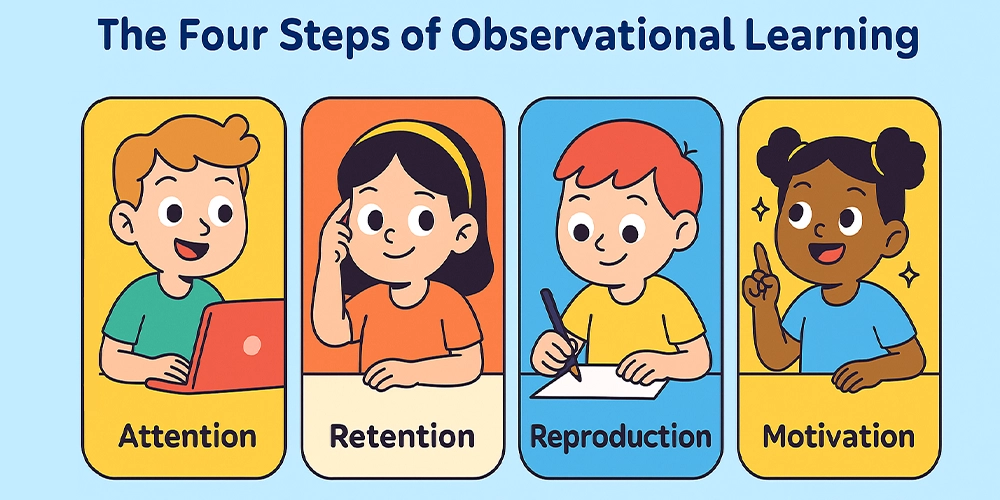
Social Learning Theory vs. Social Cognitive Theory
Social Learning Theory and Social Cognitive Theory are closely related, but they are not the same. Both are important in early childhood education, and understanding their differences helps teachers and parents use the right approach for children’s learning and behavior.
What is Social Learning Theory?
Social Learning Theory, created by Albert Bandura, explains that children learn by observing others, copying their actions, and noticing what happens as a result. It is focused on the power of modeling, imitation, and reinforcement. In Social Learning Theory, what children see others do—especially adults and peers—becomes the blueprint for their behavior. This theory is constructive for understanding social development in preschool and primary education.
What is Social Cognitive Theory?
A few years after he introduced Social Learning Theory, Bandura expanded his ideas and called this new version Social Cognitive Theory. This updated theory includes everything from Social Learning Theory, but adds a new focus on how children think about and understand what they observe. Social Cognitive Theory highlights that children are not just copying what they see—they are thinking about what actions mean, imagining what could happen, and deciding what fits their own goals and feelings.
For example, a child might watch a classmate get praised for helping to clean up. With Social Learning Theory, the child might try to help next time, hoping for the same praise. With Social Cognitive Theory, the child also thinks, “Will I feel good if I help? Will my friends like me more? Is this something I want to do?” Their thoughts and personal motivations shape what they choose to copy.
Key Differences Between the Two Theories
| Aspect | Social Learning Theory | Social Cognitive Theory |
|---|---|---|
| Founder | Albert Bandura | Albert Bandura |
| Se concentrer | Learning by observing and copying others (modeling, imitation) | Learning by observing, but also thinking, planning, and reflecting |
| Role of the Learner | Passive—mainly copies what is seen | Active—makes choices, sets goals, reflects on actions |
| Importance of Thought | Less focus on thinking, more on behavior | Strong focus on mental processes, understanding, and self-regulation |
| Motivation | Comes from seeing rewards or punishments | Comes from personal goals, feelings, and beliefs |
| Use in Classroom | Modeling, reinforcement, peer examples | Modeling plus teaching problem-solving, self-control, and reasoning |
| Keywords | Social Learning Theory, classroom modeling, reinforcement | Social Cognitive Theory, child self-efficacy, reflective thinking |
Why Both Theories Matter in Early Childhood Education
Both Social Learning Theory and Social Cognitive Theory are valuable for teachers and parents.
- Social Learning Theory gives simple, clear steps for showing and reinforcing positive behavior in the classroom.
- Social Cognitive Theory helps adults understand how children’s thoughts, emotions, and personal goals influence what they do.
By using both, teachers can model good behavior, encourage thinking and problem-solving, and support children in making positive choices for themselves and the group.
Comparing Social Learning Theory with Other Early Childhood Theories
While Social Learning Theory is influential on its own, understanding how it is similar to—and different from—other classic theories gives teachers and parents a clearer picture of how children grow and learn. Here’s how Social Learning Theory stands apart from other famous early childhood theories:
Social Learning Theory vs. Piaget’s Theory of Cognitive Development
Piaget believed children learn in specific, universal stages, moving from simple sensory experiences to more complex, logical thinking as they grow. In his view, children build knowledge through hands-on exploration and problem-solving, not just by copying others.
In contrast, Social Learning Theory highlights the importance of observation and imitation. While Piaget’s theory emphasizes self-driven discovery, Social Learning Theory explains how children often learn social skills, language, and classroom routines by watching peers and adults. For example, while Piaget would focus on how a child discovers counting with blocks, Social Learning Theory would look at how a child copies a classmate’s way of sorting or sharing blocks.
Learn more about Piaget in our [Piaget guide].
Social Learning Theory vs. Vygotsky’s Sociocultural Theory
Vygotsky’s theory centers on the role of language, culture, and social interaction in learning. He introduced the concept of the “Zone of Proximal Development,” where children learn best with support from more knowledgeable others.
Social Learning Theory agrees that social interaction is essential, but adds that simple observation—without direct teaching or scaffolding—can lead to learning. Where Vygotsky emphasizes guided participation and dialogue, Social Learning Theory shows how kids pick up behaviors and social norms just by watching.
For example, Vygotsky might explain learning as a teacher helping a child write their name, step by step. Social Learning Theory adds that a child might learn the same skill by simply watching a friend do it over and over.
Read more about Vygotsky in our [Vygotsky article].
Social Learning Theory vs. Montessori’s Method
Maria Montessori believed children are naturally curious and learn best in prepared environments that encourage exploration and independence. Her approach uses hands-on materials, self-directed activity, and respect for the child’s pace.
While both Social Learning Theory and Montessori see value in the environment, Social Learning Theory places more weight on the presence of role models. In a Montessori classroom, a child may learn how to use a new tool by watching an older peer or adult demonstrate, fitting Social Learning Theory’s idea of observational learning.
Montessori’s focus is on “learning by doing,” while Social Learning Theory is on “learning by watching and then doing,” especially in social or group situations.
Explore more about Montessori in our [Montessori overview].
Social Learning Theory vs. Erikson’s Psychosocial Stages
Erik Erikson’s theory focuses on emotional and social development across eight stages of life. In early childhood, he highlights the importance of trust, autonomy, and initiative.
Social Learning Theory complements Erikson by explaining how children develop these traits. For example, a child may develop initiative not only through encouragement but by seeing classmates take risks and be praised. Social Learning Theory provides the “how” to Erikson’s “what,” explaining how traits and skills are passed along in real settings.
Discover more about Erikson in our [Erikson summary].
Social Learning Theory vs. Reggio Emilia Approach
The Reggio Emilia approach is based on the idea that children are strong, capable, and curious learners who thrive in creative, collaborative environments. Teachers act as co-learners and guides, and the children’s interests often drive projects. There’s a strong emphasis on expressing ideas through art, discussion, and group work.
Social Learning Theory fits well with Reggio Emilia, especially in its focus on learning through social relationships and observation. Both value the classroom as a community where children learn from each other. Still, Social Learning Theory offers a more straightforward explanation for how imitation, modeling, and group reinforcement work in everyday learning.
Explore more about Reggio Emilia in our [Reggio d'Émilie overview].
Social Learning Theory vs. Waldorf (Steiner) Education
Waldorf education, founded by Rudolf Steiner, emphasizes imagination, creativity, rhythm, and the holistic development of mind, body, and spirit. Learning is hands-on, nature-inspired, and integrated across arts and academics. There’s a focus on routine, storytelling, and minimizing competition or testing.
Social Learning Theory overlaps with Waldorf in the importance placed on teacher modeling, classroom community, and learning through observation. However, Waldorf schools emphasize imitation mainly in the early years, while Social Learning Theory describes modeling and vicarious reinforcement as central to learning at all ages.
Read more about Waldorf education in our [Waldorf guide].
Social Learning Theory vs. Bowlby’s Attachment Theory
John Bowlby’s Attachment Theory describes how children form emotional bonds with caregivers, which shape their sense of security and ability to form relationships. He emphasizes the need for stable, responsive care.
Social Learning Theory doesn’t focus on attachment itself, but it does explain how children learn emotional expressions and relationship skills by observing interactions between caregivers, teachers, and peers. In this way, Social Learning Theory adds detail to Bowlby’s ideas by showing how children copy behaviors that support or challenge attachment.
See more about Bowlby’s theory in our [Attachment Theory resource].
| Theory | Key Focus | How Learning Happens | Social Learning Theory’s Unique Role |
|---|---|---|---|
| Piaget’s Cognitive Development | Stages, self-discovery | Hands-on exploration, active problem-solving | Adds peer/adult modeling, observation |
| Vygotsky’s Sociocultural Theory | Social interaction, culture | Guided support, language, scaffolding | Emphasizes learning just by watching others |
| Montessori Method | Environment, independence | Self-directed activity, sensory materials | Highlights role models in group learning |
| Erikson’s Psychosocial Stages | Social-emotional growth | Resolving emotional challenges at each stage | Explains how traits/skills are modeled |
| Bowlby’s Attachment Theory | Emotional bonds, security | Responsive caregiving, secure relationships | Shows how children copy emotional behaviors |
| Social Learning Theory | Observation, imitation | Watching, copying, reinforcement | Direct focus on modeling and vicarious learning |
Applications in Preschool Curriculum and Lesson Planning
Social Learning Theory isn’t just a theory for textbooks—it’s a practical approach that shapes how preschool teachers plan lessons, design activities, and build classroom routines. By weaving modeling, imitation, and positive reinforcement into everyday life, teachers can help children develop essential social, emotional, and learning skills.
Designing the Preschool Curriculum with Social Learning Theory
A curriculum built on Social Learning Theory makes observation and modeling a key part of every learning goal. This means:
- Teachers act as role models: From greeting children at the door to handling problems calmly, every action by a teacher is a lesson in itself.
- Group learning is central: Daily routines, circle times, and group projects are planned so children can see and copy positive behaviors from both adults and peers.
- Opportunities for observation: The classroom is set up with open areas, centers, and group seating so children can easily watch others, join activities, and try new skills.
For example, a curriculum might include weekly “helping hands” jobs, rotating leadership roles, or peer-assisted activities, giving every child a chance to watch, practice, and eventually model key skills.
Lesson Planning with Social Learning Theory
Lesson planning in Social Learning Theory classrooms means thinking about more than just what to teach—it’s about how to teach so children can see, copy, and succeed together.
Practical lesson planning strategies:
- Role-play and dramatic play: Lessons often start with a demonstration (by the teacher or a student) of sharing, conflict resolution, or polite conversation. Then, children act out these scenarios, practicing what they have observed.
- Story-based modeling: Teachers choose books and stories that show positive social interactions, empathy, and problem-solving. After reading, children discuss and sometimes reenact what they saw.
- Peer learning activities: Older or more skilled students help teach routines, lead games, or assist with classroom jobs. These peer models are a powerful part of the Social Learning Theory classroom.
- Visible reward systems: Teachers use sticker charts, class points, or “kindness walls” to show everyone how positive behaviors are noticed and celebrated.
Example Lesson Plan Using Social Learning Theory
Theme: Partage et tour de rôle
Objective: Children will learn how to share materials and wait for their turn through observation and practice.
Plan:
- The teacher models sharing a toy and asking politely for a turn.
- Children observe as two peers act out the same scenario.
- The class is split into small groups to practice sharing toys, with adults circulating to reinforce positive behaviors.
- When children successfully share or wait their turn, they receive verbal praise or a sticker for the class chart.
- At the end of the activity, the class discusses how sharing made the activity more fun for everyone.
This kind of lesson plan shows how Social Learning Theory for preschool teachers turns theory into everyday classroom practice.
Daily Routines and Social Learning Theory
Social Learning Theory doesn’t just guide formal lessons—it shapes every part of the preschool day:
- Arrival and morning routines: Teachers model greetings, handwashing, and organization. Children watch, copy, and eventually do these tasks independently.
- Transitions: Teachers use songs, signals, or gestures to model quiet transitions between activities. Children learn to follow these cues by seeing classmates respond.
- Snack and mealtime: Teachers demonstrate table manners, encourage polite conversation, and support children in helping each other.
- Cleanup: The whole group participates, with teachers modeling teamwork and praise for helping hands.
Using Materials and Environment to Support Social Learning
- Visual schedules: Help children know what’s next and see how others follow routines.
- Classroom jobs: Rotating responsibilities (like line leader or snack helper) give every child a chance to be a role model.
- Learning centers: Designed so children can watch each other explore, play, and solve problems together.
Ongoing Assessment and Adjustment
Teachers using Social Learning Theory regularly reflect on which behaviors and skills are being picked up quickly, and which may need more modeling or practice. If negative behaviors start to spread, teachers review classroom models, routines, and reinforcement strategies to get everyone back on track.
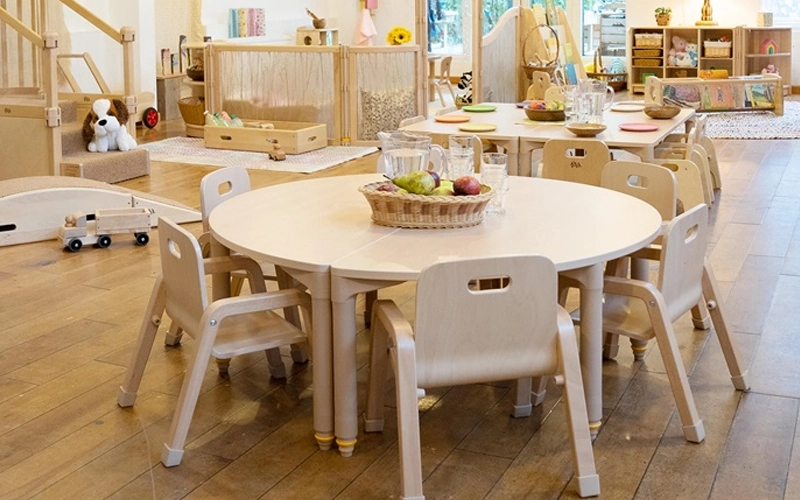
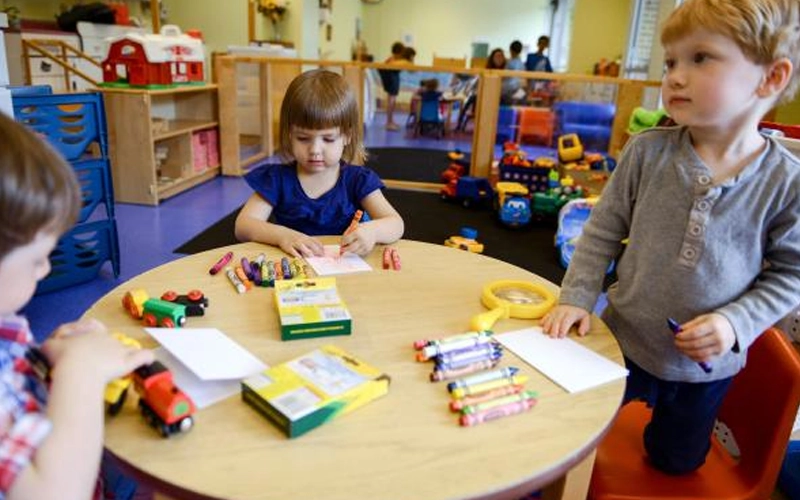
Social Learning Theory-Inspired Products and Classroom Environment
The classroom environment is a living part of Social Learning Theory. Every chair, table, shelf, and learning tool shapes how children watch, interact, and learn from each other. The right products and setup not only support healthy habits and social skills but can also boost engagement, make transitions smoother, and turn every part of the day into a social learning moment.
Why Environment Matters in Social Learning Theory
In Social Learning Theory, children don’t just learn from adults—they learn from the world around them. A well-designed classroom gives children clear opportunities to observe, imitate, and practice positive behavior. When teachers and families invest in the right furniture and educational products, they’re making it easier for children to learn by example.
Essential Furniture for Social Learning
- Round and Group Tables: Promote eye contact, conversation, and teamwork. Children seated at round tables are more likely to observe and copy good habits from their peers.
- Modular Seating: Flexible cushions, benches, or movable mats create spaces for group play, circle time, and peer modeling.
- Open Shelving and Accessible Storage: When toys and materials are easy to see and reach, children naturally observe what others are doing and join in. This supports shared discovery and imitation.
- Dramatic Play Corners: Puppet theaters, kitchens, and dress-up stations turn role-play into a daily activity. Children practice social scenarios and learn by watching others.
Learning Materials that Boost Social Modeling
- Reward Charts and Visual Boards: Display class goals, celebrate acts of kindness, or track helpful behaviors. When children see their name or a friend’s on the board, it motivates everyone to imitate those actions.
- Classroom Displays: Post photos of children working together, show collaborative art projects, or highlight “Student of the Week.” Visual displays help kids recognize positive modeling in action.
- Group Games and Building Sets: Choose toys and puzzles designed for team play, encouraging children to solve problems, share, and teach each other.
- Books and Posters Featuring Social Themes: Select stories and images showing friendship, problem-solving, and empathy. These serve as ongoing models for classroom discussion.
Wise Product Choices for Home and School
Bringing Social Learning Theory home is easy with a few thoughtful products:
- Family reward charts et visual schedules make routines clear and reinforce positive modeling at home.
- Shared reading nooks et group craft tables turn daily habits into chances for observation and teamwork.
- Mirrors, science centers, and discovery tables support self-observation and collaborative learning.
How Product Choices Drive Lasting Results
The best classroom and home environments are designed for visibility, flexibility, and group learning. The right materials don’t just look good—they inspire children to pay attention, practice together, and celebrate each other’s successes. When teachers and parents invest in these products, they’re not just filling a space—they’re building a foundation for lifelong social skills and teamwork.
Want to create an actual Social Learning Theory classroom or home?
Start by upgrading to group tables, accessible storage, role-play kits, and visual displays. Every smart purchase makes social learning more natural, fun, and successful for every child.
Votre salle de classe idéale est à un clic !
Integrating Social Learning Theory into Classroom Management
A well-managed classroom is more than just quiet lines and neat rows; it’s a vibrant space where children feel safe, respected, and ready to learn from each other. Social Learning Theory gives teachers a practical toolkit for classroom management that goes beyond rules, focusing on modeling, observation, and positive reinforcement to shape behavior naturally.
Setting Clear Expectations Through Modeling
Teachers using Social Learning Theory start with themselves. Every day, they model the language, tone, and problem-solving strategies they want children to adopt. When a teacher greets students with a smile, patiently solves problems, and shows respect for each child, those behaviors quickly become the norm in the classroom.
Classroom example:
During circle time, the teacher says, “Let’s use our listening ears,” then shows what good listening looks like—eye contact, quiet mouths, and still hands. Children follow not because they are told, but because they see the model in action.
Using Peer Influence and Positive Role Models
In preschool and early childhood classrooms, children notice which behaviors get attention and approval. Teachers can use this peer influence by highlighting “classroom stars”—students who demonstrate helpfulness, sharing, or problem-solving. This creates a ripple effect, as children naturally imitate those who are celebrated.
Classroom example:
The teacher introduces a “kindness catcher” award, recognizing students who help a friend or use kind words. Photos and names are posted on a visible board, encouraging everyone to model these actions.
Reinforcement and Consistency
Social Learning Theory classroom management relies on renforcement positif—praise, high-fives, stickers, and class cheers for good choices. The goal is to make positive behaviors visible and attractive to others.
- Classroom rules: Rather than posting a long list, teachers model each rule and discuss why it matters. For example, instead of “No running,” the teacher demonstrates “Walking feet keep us safe.”
- Consistency: Teachers respond to misbehavior with calm, predictable strategies—redirecting, reminding, or having a short conversation. Over time, students learn to self-regulate by watching how problems are handled.
Group Problem-Solving and Reflection
Social Learning Theory also supports a collaborative approach to challenges. When issues arise (like sharing or cleanup), the teacher involves the group in finding solutions.
Classroom example:
After a disagreement over toys, the teacher gathers the group and says, “What did we notice? How can we solve this together next time?” Children share ideas, watch others’ suggestions, and learn new strategies from the group.
Building Self-Regulation Through Social Learning
As children see classmates manage emotions, ask for help, or recover from mistakes, they learn these self-regulation skills for themselves. Teachers reinforce this by noticing and praising not just the outcome, but the effort and growth along the way.
Classroom example:
A student who is upset uses a “calm-down corner” with soft pillows and sensory tools. The teacher models deep breathing and invites the class to try together, building a shared culture of emotional awareness.
The Power of Visual Tools in Classroom Management
- Visual schedules et classroom rules charts remind children of routines and expectations, making positive behavior easier to imitate.
- Reward boards, star charts, et “caught being good” cards give public recognition and encourage children to notice and copy positive acts.
Why Social Learning Theory Makes Management Easier
When teachers use Social Learning Theory, classroom management feels less like controlling and more like coaching. Children learn that their actions matter—not just because of rules, but because their choices shape the whole group. Over time, this approach builds a supportive, self-managing community where positive behaviors become second nature.
Criticisms and Limitations of Social Learning Theory
Social Learning Theory is practical, widely used, and easy for teachers and parents to apply. However, no theory is perfect. Understanding the limitations of Social Learning Theory helps educators make wise choices, blend approaches, and support every child’s needs.
Not All Children Learn the Same Way
Social Learning Theory emphasizes learning by observation, but not every child copies what they see, at least not right away.
- Some children are more independent, shy, or simply interested in different things.
- Children with inevitable developmental delays or neurodiversity may need more direct teaching, repetition, or other supports beyond just modeling.
This means teachers should use Social Learning Theory as one tool, not the only method, in the classroom.
Over-Focus on External Behavior
One common criticism is that Social Learning Theory pays more attention to what children do, and less to what they think or feel inside.
- Deep beliefs, motivations, and emotional needs may not always be addressed if teachers focus only on visible actions.
- Children might imitate behaviors without fully understanding their meaning or value.
This is why many educators combine Social Learning Theory with other frameworks, like social-emotional learning, self-reflection, or even direct instruction.
Limited Attention to Individual Differences
Social Learning Theory is excellent for group settings, but it can overlook individual personalities, learning speeds, and family backgrounds.
- What works for one child might not work for another, especially if cultural values or home environments are very different.
- Children who are introverted or anxious may be less likely to participate in group modeling or peer activities.
Teachers using Social Learning Theory need to pay close attention to each child and adapt strategies as needed.
The Risk of Negative Modeling
Just as children copy positive behaviors, they can also pick up negative habits or language, especially if these are rewarded with laughter, attention, or peer approval.
- Social Learning Theory classroom management must address and redirect negative modeling quickly to prevent it from spreading.
- Teachers and parents should be careful with their own words, reactions, and body language, as children are always watching.
Not a Complete Solution for All Learning
Social Learning Theory is best for teaching social skills, routines, and basic behaviors, but some academic or complex problem-solving skills may require other teaching methods, like explicit instruction, inquiry-based learning, or one-on-one support.
Ongoing Need for Adult Involvement
Some critics point out that Social Learning Theory relies heavily on the presence of strong role models and positive environments.
- If adults are stressed, distracted, or inconsistent, children may not get the best examples to follow.
- Peer modeling is powerful, but it also needs adult guidance to keep learning positive and purposeful.
When to Combine Theories
Most experts recommend blending Social Learning Theory with other early childhood education theories and practices, such as:
- Direct instruction for new or abstract concepts
- Emotional coaching for self-regulation
- Individualized supports for children with unique needs
A flexible approach ensures that all children have the best chance to thrive, whether they learn best by watching, doing, thinking, or a mix of all three.
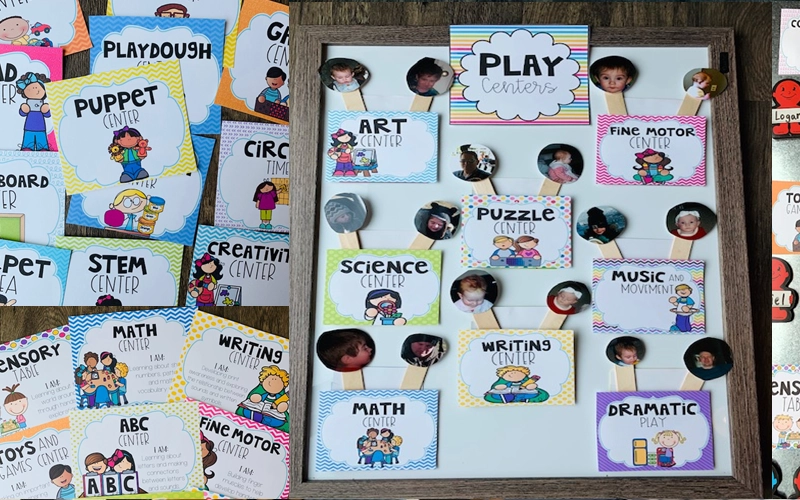
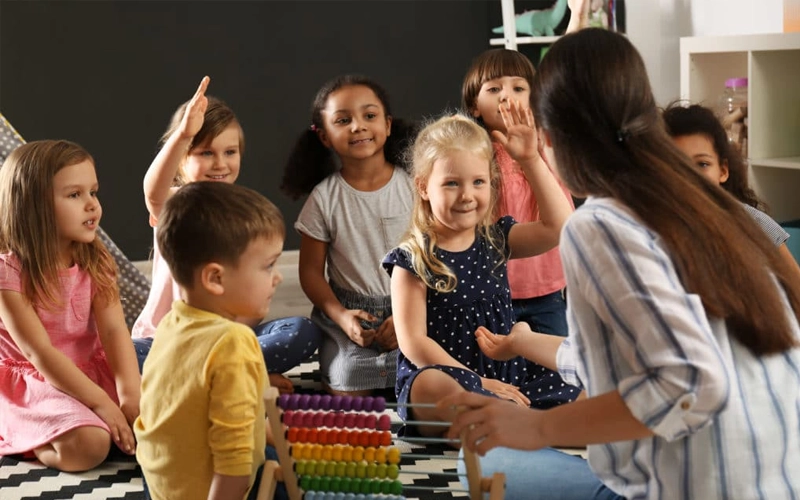
Conclusion
Social Learning Theory remains one of the most effective and accessible tools for shaping young children’s behavior, social skills, and classroom culture. By making modeling, observation, and positive reinforcement part of daily life, teachers and parents can turn every moment—whether in the classroom or at home—into a meaningful learning opportunity.
While no single theory can answer every challenge in early childhood education, Social Learning Theory offers a simple roadmap: let children watch and practice what works, encourage them with real examples, and celebrate every step forward together. When combined with other thoughtful teaching methods and tailored to each child’s needs, Social Learning Theory creates environments where every child can learn, belong, and thrive.
Whether you are a teacher designing a lesson, a parent shaping routines at home, or a school leader building a classroom community, the practical power of Social Learning Theory is always within reach. With intention, consistency, and care, you can guide children toward positive behaviors and strong relationships—one modeled moment at a time.
FAQ
What is Social Learning Theory in early childhood education?
Social Learning Theory in early childhood education is the idea that children learn important skills and behaviors by watching and imitating adults, teachers, and peers in real-life settings. This theory helps teachers and parents use modeling, group activities, and positive reinforcement to shape social and emotional development.
How can teachers use Social Learning Theory in preschool classrooms?
Teachers can apply Social Learning Theory in preschool by modeling positive behavior, using role-play and group projects, setting up reward charts, and encouraging peer modeling. This makes classroom routines, sharing, and problem-solving easier for children to understand and practice.
What are some Social Learning Theory activities for young children?
Popular Social Learning Theory activities for children include role-playing social scenarios, group storytelling, buddy systems, collaborative games, reward charts, and using visual schedules. These activities help children observe, imitate, and master new social skills in a safe environment.
How does Social Learning Theory support classroom management?
Social Learning Theory supports classroom management by encouraging teachers to model desired behaviors, reinforce positive actions, and use peer influence to shape group habits. Strategies like classroom rules charts, public praise, and visible reward systems make good behavior more likely to be copied.
What are examples of Social Learning Theory in preschool education?
Examples include children learning to line up by watching others, using polite language after hearing their teacher, or joining clean-up routines because they see classmates being praised for helping. Teachers often use modeling, storytelling, and group activities to demonstrate and reinforce these behaviors.
How does Social Learning Theory relate to child development?
Social Learning Theory and child development go hand-in-hand, especially in the early years. By observing and imitating adults and peers, children develop self-regulation, social skills, and emotional awareness. Positive reinforcement and role modeling help children build confidence and independence.
What classroom materials support Social Learning Theory?
Effective classroom materials include round group tables, open shelves, puppet theaters, reward charts, visual schedules, and books about social skills. These products create environments where children can observe, imitate, and learn from each other every day.
How do parents use Social Learning Theory at home?
Parents use Social Learning Theory at home by being positive role models, creating family reward charts, using consistent routines, and encouraging siblings to model helpful behaviors. Simple daily actions—like showing patience, sharing, or apologizing—are powerful lessons children quickly learn to imitate.

